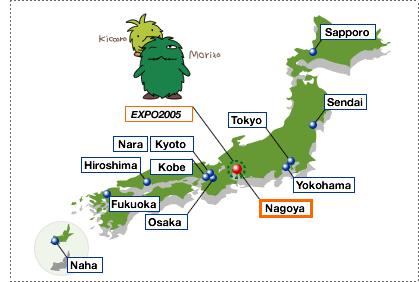Geography / Population / Language
Geography
Japan is an island country located in Northeast Asia and surrounded by the Pacific Ocean, the Sea of Japan, the East China Sea, and the Sea of Okhotsk. With a land area of around 377,883 square kilometers (as of 2002), Japan ranks 59th out of the world's 191 countries in terms of land area size.
*Comparison of land area with other countries (Unit: thousand sq. km.)
|
 |
Most of the territory of Japan is on four main islands (the northern island of Hokkaido, 83,000 sq. km.; the main island of Honshu, 231,000 sq. km.; the smallest of the four, Shikoku, 19,000 sq. km.; and the southern island of Kyushu, 42,000 sq. km.), with the remainder being made up of some 4,000 much smaller islands (around 400 are inhabited). Japan stretches obliquely north to south in a fairly long and narrow pattern, and mountains from 2,000 to 3,000 meters high range along the Japanese archipelago much like the spine of the country. Many rivers, large and small, flow out of these mountains down to their final destinations. Large plains open up as these rivers near their estuaries, and since long ago various industries have developed and prospered in these large regions favored by fertile soil. With the beauty of its coastline characteristic of a country in a volcanic zone, verdant mountainous regions in which mountains and valleys stretch in intertwining patterns, and the plentiful bounty of the sea produced by marine currents, it is nearly impossible to describe in a brief summary all of the natural attractions of Japan.
Population
Japan has a population of over 126 million people, the majority of whom reside in urban areas. Around 12 million people live in Japan's capital, Tokyo, which extends from the central part of the city, where the core functions of the country are concentrated, through surrounding suburban areas to the outlying Izu Seven Islands. Although the Japanese people are generally said to be of a single ethnicity and race, the ethnic Ainu people have been living for a historically long period of time in various areas of Ezochi (now Hokkaido) and have developed their own unique culture. The Ryukyu people living in present-day Okinawa have also developed, and are carefully preserving, their own special traditions and culture.
Population of Major Cities (estimated)
|
 |
Language
Japan has only one official language -Japanese- but several dialects of Japanese have developed within the differing environments -historical, cultural, and natural- of each region. These dialects differ from standard Japanese not only in word inflection and intonation but also in vocabulary itself. In spite of that, most Japanese, particularly the younger generation, can understand and speak standard Japanese.
The ability of Japanese people to use English is improving year by year, and foreign travelers can communicate in English at major hotels in urban areas and at international airports. Signs in English (and in Hangul in some areas) are also posted in most public facilities and buildings (government and municipal offices, public transportation facilities, etc.), large commercial facilities, and tourist locales. In subways and main JR train lines, almost all announcements of destinations and approaching stations are given in both Japanese and English.
In schools, English is a required subject for three years in junior high school, which is compulsory in Japan, and it is also included in the mandatory curriculum in both high schools and universities. At some private high schools, students also learn another language besides English as a second foreign language.
With improvements in the quality and duration of English education for children and overseas study, the numbers of Japanese who are able to cope in English should continue to increase in the future. However, compared to other Asian countries, many people in Japan are poor at conversing in English -reading and writing are another matter- so foreign travelers would do well to write communications on paper and show it to the person from whom information is being sought, and to speak slowly. As many taxi drivers do not speak English, travelers should write down, or have written, the name of the desired destination, hotel name, etc. and hand the paper to the driver. The number of people who can speak other languages besides English (French, Spanish, Chinese, Korean, etc.) is very limited.
Tokyo| Sapporo| Sendai| Yokohama| Osaka| Kyoto| Kobe| Hiroshima| Fukuoka| Okinawa


